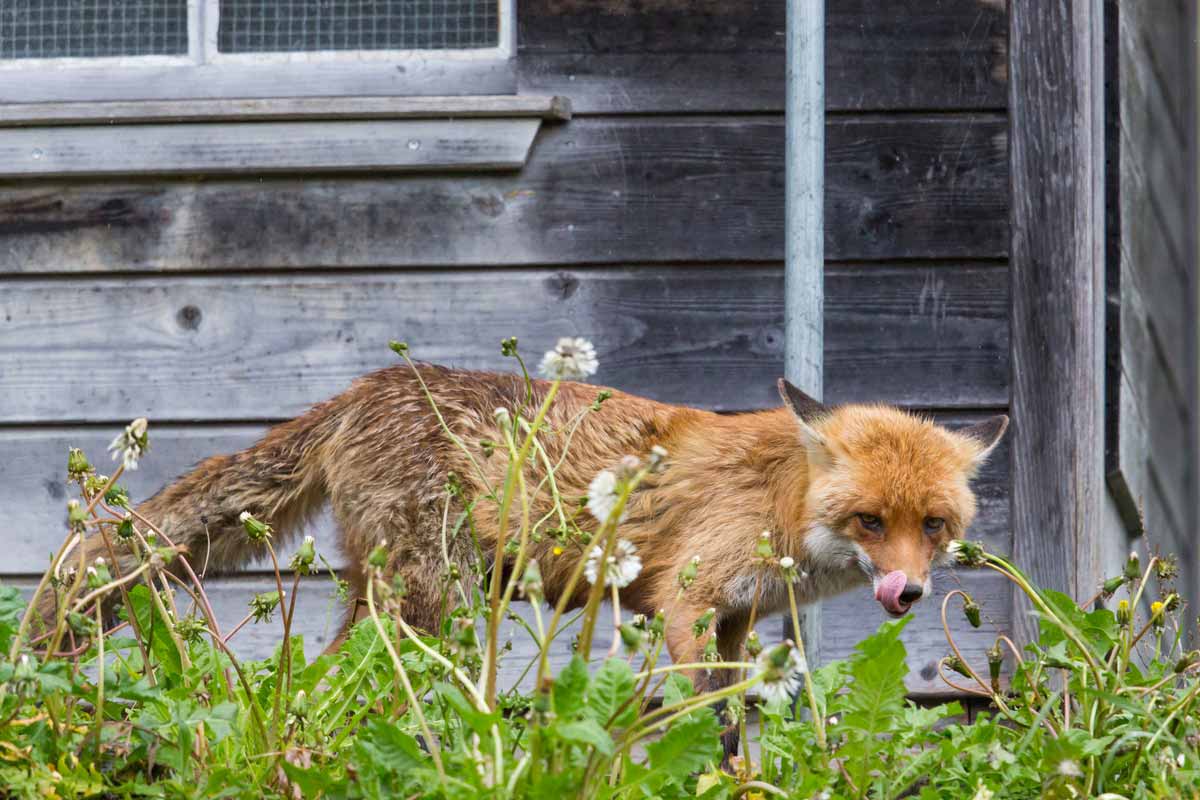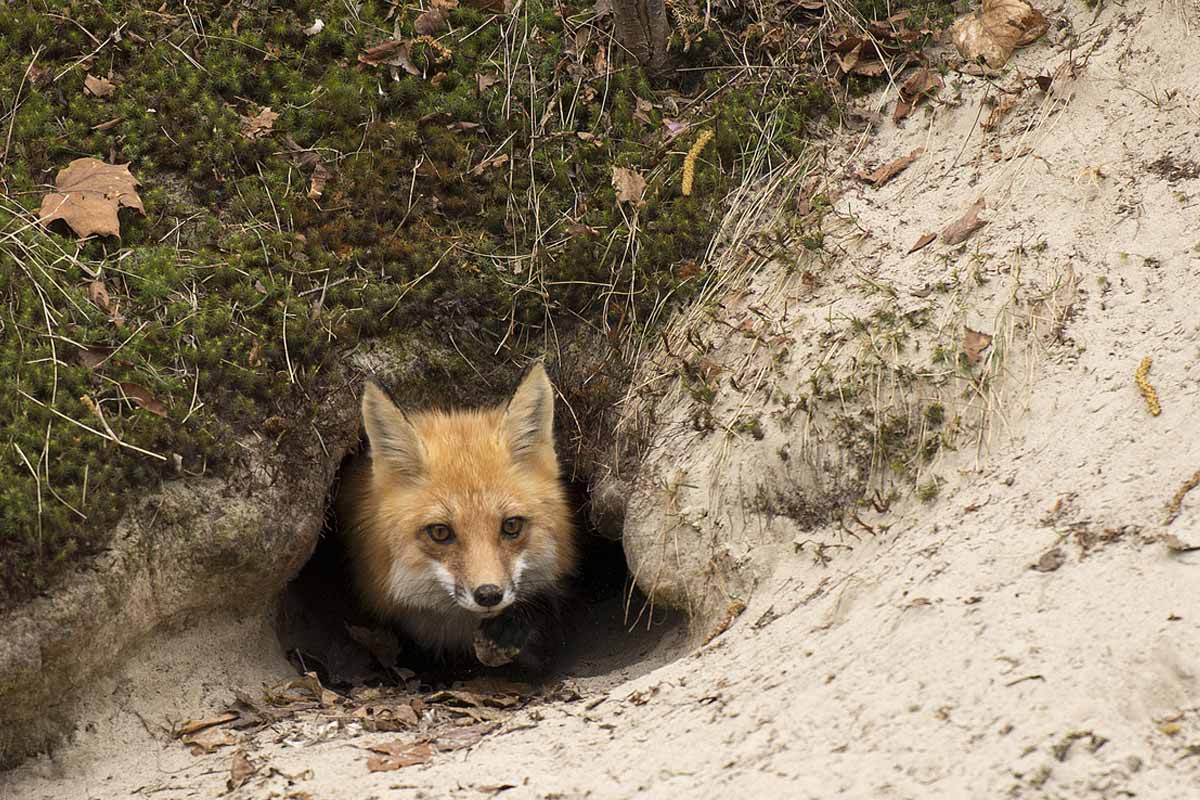How to Get Rid Of Foxes
37 min read Updated for March, 2019
Foxes are members of the Canidae family along with wolves, dogs, and jackals. They are skittish animals with a healthy fear of humans and will always choose to run away rather than confront a person in their path. They are generally seen as a beneficial species because they help to control rodent populations. Foxes are an abundant species that is native to North America and can be found in every state in the U.S. and most parts of Canada. Despite their large numbers, they are fairly elusive as they are mostly nocturnal and move carefully to maintain cover at all times.
If you do spy a fox on your property, it is likely passing through, and you should enjoy the moment to observe such a beautiful and fascinating creature. However, foxes are opportunistic feeders that will stick around if they find an easy food source or a suitable den for kits. They have become well adapted to living in urban areas in close proximity to humans and will scavenge through garbage and eat pet food. Despite this, they are adept hunters and eat a wide range of foods from moles, voles, and mice to vegetation and insects. Though foxes rarely conflict with humans, they can create trouble for farmers and rural landowners when they prey on small livestock, chickens, and eggs.
The good news is that there are a lot of humane and effective ways to evict foxes from your property if you cannot coexist with them. In this article, you will find everything you need to know about when and how to get rid of foxes.
37 min read Updated for March, 2019

Fox Sounds
The most common sounds heard from the red fox are a quick series of barks, but more intense is its chilling, screechy take of a howl. The shrill, hoarse, almost scream of anguish, is usually heard during breeding season. Outside of the barks and screams, foxes will use a quieter form of communication, kind of a guttural chattering with the odd yelp or howl known as ‘gekkering’.
Fox Tracks
Fox tracks look like a chevron with four toes and a pad, leaving somewhat of a triangular shape. Gray fox tracks are a little more clearer to identify as they have less fur than their red counterparts. In both species, however, the middle toes have distinguishing claw marks that set the track—or top of chevron—off.
Fox Poop
Fox poop is generally rope-like, segmented and tapered, full of fur, tiny bones, seeds, and berries. In rural areas fox poop tends to be quite dark, but in urban areas where foxes have access to human food, it can be somewhat lighter.
Identify
Physical Characteristics
The most distinguishing characteristic of foxes is their long, bushy tail, also called a brush. It accounts for over a third of their total body length and serves a variety of purposes from keeping them warm to communicating with one another.
While foxes are related to dogs, they have some features that read as feline more than canine. For instance, unlike dogs who have round eyes, foxes have oval eyes with vertical pupils like those of a cat. They also have black, cat-like whiskers that are much longer than their dog cousins.
Although foxes vary in size and appearance depending on their location and species, all “true foxes” are similar in that they have a flattened skull, upright triangular ears, an upturned snout, and a long bushy tail.
Common Species
While there are 37 species of foxes, only 12 belong to the genus Vulpes, known as the “true foxes.” Of these 12, three types can be found in North America: red fox, arctic fox, and kit fox. Grey foxes are the fourth type that can be found in North America, though they are not of the Vulpes genus.

Red Fox (Vulpes vulpes)
The largest of the “true foxes” is the red fox standing 15 inches tall at the shoulder and weighing 8-14 pounds. They get their name from their rusty red coat, though three distinct color variations occur: red, silver/black, and cross. The classic red coloration includes a red coat with black “stockings” the extend to the feet, a white underside, and a tail with a white tip. They are the only fox that has partially retractable claws for stealthier hunting.
Gray Fox (Urocyon cinereoargenteus)
There are several ways to readily distinguish a red fox from a gray fox, as the color is not always reliable since their coats can be similar in color depending on the animal and time of year. The most obvious difference is the color at the tip of their tail— gray foxes have a black tip where red foxes have a white tip. Grey foxes are slightly smaller, ranging from 7-11 pounds, though their bodies are typically a bit longer. Their coats are a silvery grey color with tinges of red at the sides of the neck, belly, and legs. They are the only canid that can climb trees.
Arctic Fox (Vulpes lagopus)
The arctic fox has a warm, thick coat to help it survive the cold, arctic regions of the Northern Hemisphere. There are two color variations —white and blue. Ninety-nine percent of arctic foxes are the white morph, meaning that they change from white in the winter to greyish-brown in the summer. They have a more compact body with small rounded ears and a short muzzle to preserve body heat. Their feet have fur-covered soles.
Kit Fox (Vulpes macrotis)
The smallest wild canid in North America, the kit fox weighs three to six pounds. It lives in desert climates and is most readily recognized by its large ears that lower its temperature and give it an excellent hearing. It has gray fur that may be tinged with red, and its tail has a black tip. They have fur on their paw pads for traction in the desert and protection on hot surfaces.
Treating Your Property For Foxes
Foxes are secretive, sensitive animals that can easily be driven away if you treat your property with the right products. While exclusion methods that employ fences and barriers offer the most effective long-term protection, the best approach is a comprehensive, multi-pronged effort that combines several techniques.
Below you will find several humane, effective, and low-cost products that can be purchased at Amazon.com to help you repel and prevent foxes:
DIY Treatments
Foxes have highly developed senses, so negatively appealing to these can be an effective part of your plan to evict foxes from your yard. Here are a few easy concoctions and ideas that you can come up with at home to help repel foxes:
Create an unpleasant border
If you have a garden patch that seems to attract foxes on a regular basis, try planting onions, hot peppers, or garlic around the borders to deter them.
Spice things up
Make a spicy solution to spray on gardens, trash cans, and other areas that attract foxes. To make the solution, boil chopped onions, garlic, and hot peppers in two quarts of water. Strain the mixture and pour into a spray bottle. This is temporary, and the spray will need to be applied regularly.
Noisemakers
Scientists have identified noise as the number one deterrent for foxes. To repel foxes who have a den on your property, place a radio or loud bell near the den entrance to create an unbearable environment for the fox. Make sure to change the location of the noise making device on a regular basis to remain effective.
Fox Problem?
Since they pose no threat to humans, they have benefitted from the spread of humans into their environments as our presence provides easy sources of food and shelter.
Common Locations
Red foxes are the most abundant fox species in North America and the most widely scattered wild carnivore on Earth. With a range that spreads across the entire Northern Hemisphere, they are present in North America, Asia, Europe, and North Africa. They are one of the most intelligent animals, and their adaptability allows them to expand and survive in a wide range of habitats and locations.
Red foxes thrive in forests, mountains, fields, wetlands, and even suburban neighborhoods. Since they pose no threat to humans, they have benefitted from the spread of humans into their environments as our presence provides easy sources of food and shelter. In the continental US, they can be found in nearly every state, though their populations are very sparse in the Southwest, as they do not like arid, desert climates.
Gray foxes were at one time the most common fox species in the Eastern U.S., but red foxes have since taken over. Deforestation and development have impeded their growth in the Eastern states. Despite this, they are still the most abundant fox species on the West Coast. Their natural range spans from southern Canada through the U.S. and into South America. They favor woodland habitats and areas with a thick brush that provide a lot of shelter, making them more elusive. In the U.S., they live in most regions except for the open plains and the Rocky Mountains.
The arctic fox, as the name implies, inhabits the arctic tundra and sea ice, favoring areas where the ground is frozen, and the snow isn’t too deep. They are adapted to withstand environments with winter temperatures that fall well below zero. In the United States, they live in Alaska and its surrounding islands and sometimes as far south as the Hudson Bay.
The kit fox is a North American fox species that prefers hot, desert climates. They primarily inhabit the Southwest U.S. in addition to northern and central Mexico. They can also live as far north as Oregon and as far east as Colorado. They favor grasslands, sagebrush, and salt brush habitats though they will sometimes live in urban areas as well.
Red foxes and gray foxes are the primary subjects of this article since they share more habitat with humans and therefore, create more conflict and interactions.

Leaving pet food and scraps out to feed wildlife is fervently warned against by wildlife experts.
Why They’re There
If you find a fox on or near your property, it is likely a red fox as they are the most common species in North America. Here are a few of the most common reasons that they may be there:
Den for kits
When it is not breeding season, foxes prefer to live in the open. However, they will find or create a den in preparation for their kits to be born in late March to April.
Rodents
Foxes only prey on small animals like chipmunks, moles, mice, rabbits, and the like. If you have a large population of small vermin on your property, it may entice a fox to stick around. They hunt even more when kits are born in late spring.
Humans feeding them and other wildlife
Leaving pet food and scraps out to feed wildlife is fervently warned against by wildlife experts. When wild animals learn to associate you with food, they begin to lose their fear of you.
Fox Sounds
The most common sounds heard from the red fox are a quick series of barks, but more intense is its chilling, screechy take of a howl. The shrill, hoarse, almost scream of anguish, is usually heard during breeding season. Outside of the barks and screams, foxes will use a quieter form of communication, kind of a guttural chattering with the odd yelp or howl known as ‘gekkering’.
Fox Tracks
Fox tracks look like a chevron with four toes and a pad, leaving somewhat of a triangular shape. Gray fox tracks are a little more clearer to identify as they have less fur than their red counterparts. In both species, however, the middle toes have distinguishing claw marks that set the track—or top of chevron—off.
Fox Poop
Fox poop is generally rope-like, segmented and tapered, full of fur, tiny bones, seeds, and berries. In rural areas fox poop tends to be quite dark, but in urban areas where foxes have access to human food, it can be somewhat lighter.
Inspect
Should I Relocate This Animal?
Foxes will not attack you or your children as they are afraid of humans. You are at significantly higher risk of being bitten by a dog or cat. They are not dangerous unless they are rabid or they are captured and handled.
Because they prey on animals weighing no more than one or two pounds, they pose no threat to your pets either. Unless you have a litter of puppies or kittens on your property or a small animal like a rabbit or guinea pig that lives outside, there is no need for concern. If you do have a small pet, make sure you supervise them when outdoors or live in a well-secured enclosure.
It is not uncommon for foxes to create dens below existing structures like porches, decks, or sheds in urban areas. If you find a den on your property, especially in the spring, it is likely a family with kits. Consider letting them stay for a couple of months. At about nine weeks, the kits will begin to hunt with their parents. Now is an appropriate time to encourage them to move on as they will soon be ready to leave their den for good at this point anyway.

It is important to note that if you do decide to call animal control or a wildlife management service, the result will likely be fatal for the foxes. It is best to coexist and enjoy observing them, keeping in mind that their presence is temporary. After all, foxes are not destructive and are actually beneficial animals as they prey heavily on rodents, mice, and squirrels.
Having said that, there are situations when foxes can become a legitimate nuisance. For example, you may find that their presence is intolerable on your farm if they are killing chickens and rabbits or stealing eggs. In this case, the animal is preying on your livelihood and steps need to be taken to discourage them from returning.
Before considering any trapping or removal methods, it is essential to familiarize yourself with all of the laws and regulations in your state. In most, if not all states, it is illegal to relocate a trapped fox. This means that they must be euthanized once captured. Euthanization is not a humane or appealing solution for many people and does not lead to the intended solution, which is the long-term removal of the animal from your property. Getting rid of one or two foxes will not keep them away from your property permanently. The most humane strategy for getting rid of them is humane eviction. Once you have scared them off, you can take steps to prevent them from coming back and exclude them from your property more permanently.
Treating Your Property For Foxes
Foxes are secretive, sensitive animals that can easily be driven away if you treat your property with the right products. While exclusion methods that employ fences and barriers offer the most effective long-term protection, the best approach is a comprehensive, multi-pronged effort that combines several techniques.
Below you will find several humane, effective, and low-cost products that can be purchased at Amazon.com to help you repel and prevent foxes:
DIY Treatments
Foxes have highly developed senses, so negatively appealing to these can be an effective part of your plan to evict foxes from your yard. Here are a few easy concoctions and ideas that you can come up with at home to help repel foxes:
Create an unpleasant border
If you have a garden patch that seems to attract foxes on a regular basis, try planting onions, hot peppers, or garlic around the borders to deter them.
Spice things up
Make a spicy solution to spray on gardens, trash cans, and other areas that attract foxes. To make the solution, boil chopped onions, garlic, and hot peppers in two quarts of water. Strain the mixture and pour into a spray bottle. This is temporary, and the spray will need to be applied regularly.
Noisemakers
Scientists have identified noise as the number one deterrent for foxes. To repel foxes who have a den on your property, place a radio or loud bell near the den entrance to create an unbearable environment for the fox. Make sure to change the location of the noise making device on a regular basis to remain effective.
Fox Problem?
It is important to make changes that will lead to the long-term eviction of the animal from your property.
Gather The Tools You’ll Need
It is important to be considerate and thoughtful as you decide how to handle an animal that you deem to be a nuisance. The most effective plan is one that combines several preventions and exclusion methods to make your property as unappealing and inaccessible to the animal as possible. While your first instinct may be to trap the animal and relocate it, this will most likely result in the death of the animal. As long as conditions stay the same on your property, a new fox will move in anyway. So, it is important to make changes that will lead to the long-term eviction of the animal from your property.
In the sections that follow, you will find multiple lists that include tools to help you exclude, prevent, and repel foxes.

Mange is treatable in foxes and chances of a domestic cat or dog contracting mange from a fox is very slim.
Risks Of Disease
Here is a list of the most common diseases that foxes carry and the risks that they present to you and your pets:
Rabies
North American foxes can have rabies, but it is rare. Most foxes infected with rabies live in the Eastern and Southern U.S.. If transmitted to humans, post-exposure treatment is 100 percent effective.
Canine Distemper
This disease affects both wild and domestic canines and leads to eye and respiratory problems that can turn into neurological disorders. Although there is an effective vaccine for domesticated dogs, it is fatal for wild animals and can wipe out entire populations.
Mange
Sarcoptic mange is caused by parasitic mites that cause extreme skin irritation and hair loss in the infected animal. Mange is treatable in foxes and chances of a domestic cat or dog contracting mange from a fox is very slim, but is easily treated. It does not pose a threat to humans.
Fox Tapeworm
A tapeworm is a parasite that can cause severe liver disease to humans who contract it. Foxes contract the parasites from rodents, shed the eggs in feces where pets and humans pick it up through contaminated food and water. Direct transmission from foxes to humans is unlikely.
Toxocariasis
Toxocariasis is a roundworm that can be found in the intestines of dogs and foxes and transmitted between the two. You can become infected if your dog has the parasite, but children are at higher risk because they are more likely to come into contact with animal feces while playing outside.
Fox Sounds
The most common sounds heard from the red fox are a quick series of barks, but more intense is its chilling, screechy take of a howl. The shrill, hoarse, almost scream of anguish, is usually heard during breeding season. Outside of the barks and screams, foxes will use a quieter form of communication, kind of a guttural chattering with the odd yelp or howl known as ‘gekkering’.
Fox Tracks
Fox tracks look like a chevron with four toes and a pad, leaving somewhat of a triangular shape. Gray fox tracks are a little more clearer to identify as they have less fur than their red counterparts. In both species, however, the middle toes have distinguishing claw marks that set the track—or top of chevron—off.
Fox Poop
Fox poop is generally rope-like, segmented and tapered, full of fur, tiny bones, seeds, and berries. In rural areas fox poop tends to be quite dark, but in urban areas where foxes have access to human food, it can be somewhat lighter.
Prevent
Prevention Methods
If you want to prevent foxes from feeling welcome on your property, there are a variety of humane and effective ways to do it. Here is a list of some exclusion methods and repellents:
Reduce food supplies
Keep garbage containers clean and tightly sealed, bring pet food inside before dark, and clean up ground-lying fruit. A more extreme measure would be to eliminate rodents and small animals from your property that would attract a fox.

Reduce cover
Foxes favor areas that provide a lot of cover so that they can easily hide while hunting and passing from one area to another. Keep your yard as open as possible, eliminating brush piles, wood piles, and any form of cover that will make them feel safe on your property.
Fencing
Fencing is the best long-term solution for excluding foxes from your property and protecting your animals and gardens. Fences should be at least six feet tall, extend 12 inches underground and have spaces no larger than three inches. Install a mesh screen over smaller areas like animal pens or gardens. Electric fencing is an effective option when it comes to protecting livestock and poultry.
Seal off denning sites
After confirming they are not occupied, seal off any existing dens in the ground on your property. Install mesh wire to block off spaces under decks and porches, especially during the cold winter months.

Treating Your Property For Foxes
Foxes are secretive, sensitive animals that can easily be driven away if you treat your property with the right products. While exclusion methods that employ fences and barriers offer the most effective long-term protection, the best approach is a comprehensive, multi-pronged effort that combines several techniques.
Below you will find several humane, effective, and low-cost products that can be purchased at Amazon.com to help you repel and prevent foxes:
DIY Treatments
Foxes have highly developed senses, so negatively appealing to these can be an effective part of your plan to evict foxes from your yard. Here are a few easy concoctions and ideas that you can come up with at home to help repel foxes:
Create an unpleasant border
If you have a garden patch that seems to attract foxes on a regular basis, try planting onions, hot peppers, or garlic around the borders to deter them.
Spice things up
Make a spicy solution to spray on gardens, trash cans, and other areas that attract foxes. To make the solution, boil chopped onions, garlic, and hot peppers in two quarts of water. Strain the mixture and pour into a spray bottle. This is temporary, and the spray will need to be applied regularly.
Noisemakers
Scientists have identified noise as the number one deterrent for foxes. To repel foxes who have a den on your property, place a radio or loud bell near the den entrance to create an unbearable environment for the fox. Make sure to change the location of the noise making device on a regular basis to remain effective.
Fox Problem?
A dog is also an effective way to guard livestock and other small farm animals against foxes.
Get a dog
Foxes are only about ten pounds, so even the presence of a medium-sized dog on your property would be a deterrent. A dog is also an effective way to guard livestock and other small farm animals against foxes.
Smell and sound
A motion-activated sprinkler that combines motion, bursts of water, and loud noises will likely be enough to repel a fox. You can also plant a “scaredy-cat plant” which has an odor that canines can detect but humans cannot.
Fox Sounds
The most common sounds heard from the red fox are a quick series of barks, but more intense is its chilling, screechy take of a howl. The shrill, hoarse, almost scream of anguish, is usually heard during breeding season. Outside of the barks and screams, foxes will use a quieter form of communication, kind of a guttural chattering with the odd yelp or howl known as ‘gekkering’.
Fox Tracks
Fox tracks look like a chevron with four toes and a pad, leaving somewhat of a triangular shape. Gray fox tracks are a little more clearer to identify as they have less fur than their red counterparts. In both species, however, the middle toes have distinguishing claw marks that set the track—or top of chevron—off.
Fox Poop
Fox poop is generally rope-like, segmented and tapered, full of fur, tiny bones, seeds, and berries. In rural areas fox poop tends to be quite dark, but in urban areas where foxes have access to human food, it can be somewhat lighter.
When to Call a Professional
In general, foxes do not pose a threat to humans though they can prove to be a nuisance at times if they scavenge on your property or kill farm animals repeatedly. In these cases, you can typically take matters into your own hands and employ a variety of prevention and exclusion methods to deter foxes from coming back.

If you feel that you cannot solve the conflict that you are experiencing, it is definitely time to call a wildlife professional. They can offer sound, knowledgeable advice or get involved if help is needed.
The main reason you would need to contact a professional is if you see a sick or injured animal. Foxes infected with rabies or mange can be especially obvious as they may be seen in the open and can present a threat to you or your pets. It is important to call animal control if you see an injured animal as they will be able to assess the animal’s condition and provide the appropriate help.
And last, if you or your pet is bitten or scratched by a fox, seek medical help immediately. Foxes do not present a lot of risk to human health, but some of their diseases can be very dangerous and sometimes even fatal.
Sources
http://www.wildlife-removal.com/foxrepellent.html
http://www.havahart.com/how-to-repel-foxes
https://www.humanesociety.org/resources/scrap-trap-when-evicting-wildlife
https://www.welcomewildlife.com/fox-frequent-questions/
http://www.thefoxwebsite.net/populations/northamerica
https://www.worldatlas.com/articles/the-twelve-species-of-true-foxes.html
https://www.nwf.org/Educational-Resources/Wildlife-Guide/Mammals/Red-Fox
https://blog.nwf.org/2018/04/what-to-do-when-foxes-move-in/
http://www.flintcreekwildlife.org/found_an_animal/fact_sheet/i_have_a_fox_in_my_yard_neighborhood/
http://www.wildliferesponse.org/new-education/local-wildlife/foxes-of-north-america
https://www.foxesworlds.com/gray-fox/
https://www.humanesociety.org/resources/what-do-about-foxes
https://www.livescience.com/27168-foxes.html
http://www.wildlifenorthamerica.com/Mammal/Red-Fox/Vulpes/vulpes.html
http://www.wildlifeanimalcontrol.com/fox.html
https://www.britannica.com/animal/Arctic-fox
https://www.biologicaldiversity.org/species/mammals/desert_kit_fox/index.html
https://www.paws.org/wildlife/having-a-wildlife-problem/relocating-wildlife/
https://stoppestinfo.com/419-top-fox-repellents-deterrents.html
Treating Your Property For Foxes
Foxes are secretive, sensitive animals that can easily be driven away if you treat your property with the right products. While exclusion methods that employ fences and barriers offer the most effective long-term protection, the best approach is a comprehensive, multi-pronged effort that combines several techniques.
Below you will find several humane, effective, and low-cost products that can be purchased at Amazon.com to help you repel and prevent foxes:
DIY Treatments
Foxes have highly developed senses, so negatively appealing to these can be an effective part of your plan to evict foxes from your yard. Here are a few easy concoctions and ideas that you can come up with at home to help repel foxes:
Create an unpleasant border
If you have a garden patch that seems to attract foxes on a regular basis, try planting onions, hot peppers, or garlic around the borders to deter them.
Spice things up
Make a spicy solution to spray on gardens, trash cans, and other areas that attract foxes. To make the solution, boil chopped onions, garlic, and hot peppers in two quarts of water. Strain the mixture and pour into a spray bottle. This is temporary, and the spray will need to be applied regularly.
Noisemakers
Scientists have identified noise as the number one deterrent for foxes. To repel foxes who have a den on your property, place a radio or loud bell near the den entrance to create an unbearable environment for the fox. Make sure to change the location of the noise making device on a regular basis to remain effective.
Fox Problem?
Sources
https://www.popsci.com/science/article/2013-09/what-sound-does-fox-make
https://www.wildlifetrusts.org/wildlife/how-identify/identify-poo
https://www.wildernesscollege.com/fox-tracks.html
Fox Sounds
The most common sounds heard from the red fox are a quick series of barks, but more intense is its chilling, screechy take of a howl. The shrill, hoarse, almost scream of anguish, is usually heard during breeding season. Outside of the barks and screams, foxes will use a quieter form of communication, kind of a guttural chattering with the odd yelp or howl known as ‘gekkering’.
Fox Tracks
Fox tracks look like a chevron with four toes and a pad, leaving somewhat of a triangular shape. Gray fox tracks are a little more clearer to identify as they have less fur than their red counterparts. In both species, however, the middle toes have distinguishing claw marks that set the track—or top of chevron—off.
Fox Poop
Fox poop is generally rope-like, segmented and tapered, full of fur, tiny bones, seeds, and berries. In rural areas fox poop tends to be quite dark, but in urban areas where foxes have access to human food, it can be somewhat lighter.


